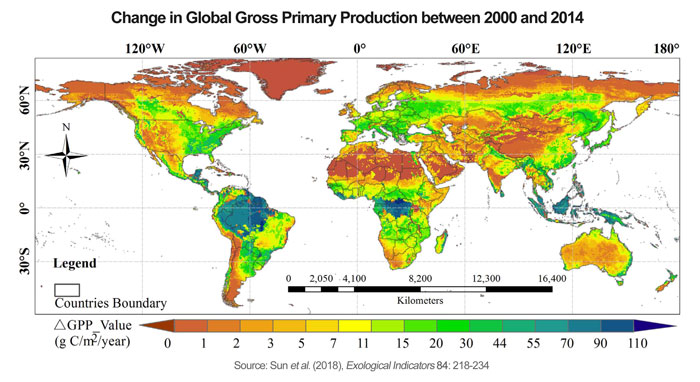| Tweet | Follow @co2science |
Paper Reviewed
Sun, Z., Wang, X., Yamamoto, H., Tani, H., Zhong, G. and Yin, S. 2018. An attempt to introduce atmospheric CO2 concentration data to estimate the gross primary production by the terrestrial biosphere and analyze its effects. Ecological Indicators 84: 218-234.
For years now, climate alarmists have been claiming that the planet is experiencing a fever. More specifically, they say that rising levels of atmospheric CO2 are causing dangerous CO2-induced global warming, which warming they assert is unprecedented for the past millennium and is wreaking havoc on the biosphere. But are these claims correct?
In short, the answer is a resounding no!
Consider, for example, the figure below, which illustrates the change in global gross primary productivity (GPP) between the years 2000 and 2014. GPP is an ecological measure of ecosystem health. Higher GPP values correspond with more productive ecosystems in terms of their ability to produce biomass (plant growth) and support the higher trophic levels up the food chain.
The graph was produced from a study by Sun et al. (2018) and reveals that GPP values are increasing everywhere across the globe, with the exception of those regions which are hostile for life (the cold and light-limiting ice caps and water-limiting deserts). This observation thus confirms that rising levels of atmospheric CO2 and recent changes in climate (temperature, precipitation, etc) have not negatively impacted the terrestrial biosphere, but rather enhanced it. What is more, the fact that the highest increases in GPP are found in locations of the lowest latitudes, suggests that a little global warming could do the terrestrial biosphere much good and would probably further enhance GPP if the planet continues to warm. Certainly GPP is not presently limited by temperature at the lower latitudes because of the great enhancement to GPP that are observed there.
Clearly, rising planetary temperatures have not reached dangerous levels and so the earth is not experiencing a fever. In contrast, the health of the terrestrial biosphere has likely never been better during the Human Age, thanks to rising levels of CO2 that are improving plant photosynthesis and growth. Additional studies supporting this conclusion can be found in our Subject Index under the heading of Biospheric Productivity.

Figure 1. The change in global gross primary production (GPP) for the terrestrial biosphere between the period 2000 and 2014. Source: Sun et al. (2018).




